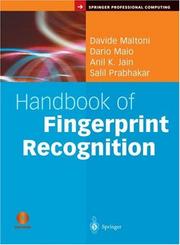| Listing 1 - 2 of 2 |
Sort by
|
Book
ISBN: 9782889151837 2889151832 Year: 2017 Publisher: Lausanne : Presses polytechniques et universitaires romandes,
Abstract | Keywords | Export | Availability | Bookmark
 Loading...
Loading...Choose an application
- Reference Manager
- EndNote
- RefWorks (Direct export to RefWorks)
La dactyloscopie a révolutionné l’identification des récidivistes et des criminels. L’avènement des banques de données automatisées a profondément transformé ce champ d’expertise, en permettant la mise en relation directe et à grande échelle, sans suspicion préalable, des traces digitales avec des empreintes digitales. Cette puissance d’identification a encouragé la recherche de nouveaux moyens de détection, participant ainsi à l’apparition d’une véritable discipline de laboratoire. C’est à l’état des connaissances, des techniques et des potentialités de la dactyloscopie que s’attache cet ouvrage, rédigé par les experts impliqués dans tous les changements majeurs de la discipline depuis ces dernières décennies. Cette somme expose l’ensemble des fondements morphogénétiques des dessins papillaires et leur influence sur la sélectivité extraordinaire de ce moyen d’identification, aborde les principes fondamentaux du processus d’identification et décortique la méthode et le processus de décision débouchant sur la preuve dactyloscopique. Il présente par ailleurs les méthodes permettant de détecter et révéler la grande majorité des traces papillaires et aborde également les questions de datation des traces, les erreurs possibles, ou les processus de qualité relatifs. Enfin, l’ouvrage appelle à une révision en profondeur du processus d’identification, qu’il présente ici de manière originale. Sans équivalent, cette référence internationale s’adresse principalement aux spécialistes du domaine et à tous ceux concernés par le processus d’identification (services d’identité judiciaire, enquêteurs, policiers, magistrats instructeurs, juges, juristes, étudiants en droit, magistrature, criminologie, police scientifique, criminalistique, science forensique, chimistes, photographes techniques). Il intéressera également et plus largement tous ceux confrontés aux nouvelles connaissances en dactyloscopie, ou désireux de comprendre l’état des connaissances, les difficultés et les défis de la dactyloscopie en ce début du 21e siècle.
Empreintes digitales --- Enquêtes criminelles --- Criminalistique --- Dermatoglyphes --- Traces (criminologie) --- Fingerprints --- Criminal investigation --- Forensic sciences --- Identification --- Fingerprints. --- Criminal investigation. --- Forensic sciences. --- Empreintes digitales. --- Enquêtes criminelles. --- Criminalistique. --- Identification. --- Dermatoglyphes. --- Fingerprints - Identification. --- Empreintes digitales - Identification. --- Enquêtes criminelles.

ISBN: 1280188529 9786610188529 0387215875 0387954317 Year: 2003 Publisher: New York, NY : Springer New York : Imprint: Springer,
Abstract | Keywords | Export | Availability | Bookmark
 Loading...
Loading...Choose an application
- Reference Manager
- EndNote
- RefWorks (Direct export to RefWorks)
Overview Biometric recognition refers to the use of distinctive physiological and behavioral character- tics (e. g. , fingerprints, face, hang geometry, iris, gait, signature), called biometric identifiers or simply biometrics, for automatically recognizing a person. Questions such as “Is this person authorized to enter the facility?”, “Is this individual entitled to access the privileged infor- tion?”, and “Did this person previously apply for a job?” are routinely asked in a variety of organizations in both public and private sectors. Because biometric identifiers cannot be easily misplaced, forged, or shared, they are considered more reliable for person recognition than traditional token- (e. g. , keys) or knowledge- (e. g. , password) based methods. Biometric recognition can provide better security, higher efficiency, and increased user convenience. It is for these reasons that biometric systems are being either increasingly deployed or evaluated in a large number of government (e. g. , welfare disbursement, national ID card, issuing of driver’s license) and civilian (e. g. , computer network logon, automatic teller machine, cellular phone, Web access, smartcard) applications. A number of biometric technologies have been developed and several of them are being used in a variety of applications. Among these, fingerprints, face, iris, speech, and hand - ometry are the ones that are most commonly used. Each biometric has its strengths and we- nesses and the choice of a particular biometric typically depends on the requirements of an application.
Electronic books. -- local. --- Fingerprints -- Classification. --- Fingerprints -- Identification. --- Fingerprints --- Engineering & Applied Sciences --- Mechanical Engineering --- Social Welfare & Social Work --- Social Sciences --- Computer Science --- Mechanical Engineering - General --- Criminology, Penology & Juvenile Delinquency --- Identification --- Classification --- Empreintes digitales --- EPUB-LIV-FT SPRINGER-B --- Computer science. --- Biotechnology. --- Computer security. --- Artificial intelligence. --- Computer graphics. --- Image processing. --- Pattern recognition. --- Computer Science. --- Systems and Data Security. --- Pattern Recognition. --- Artificial Intelligence (incl. Robotics). --- Computer Graphics. --- Image Processing and Computer Vision. --- Optical pattern recognition. --- Computer vision. --- Artificial Intelligence. --- Optical data processing. --- Chemical engineering --- Genetic engineering --- Optical computing --- Visual data processing --- Bionics --- Electronic data processing --- Integrated optics --- Photonics --- Computers --- Automatic drafting --- Graphic data processing --- Graphics, Computer --- Computer art --- Graphic arts --- Engineering graphics --- Image processing --- AI (Artificial intelligence) --- Artificial thinking --- Electronic brains --- Intellectronics --- Intelligence, Artificial --- Intelligent machines --- Machine intelligence --- Thinking, Artificial --- Cognitive science --- Digital computer simulation --- Logic machines --- Machine theory --- Self-organizing systems --- Simulation methods --- Fifth generation computers --- Neural computers --- Design perception --- Pattern recognition --- Form perception --- Perception --- Figure-ground perception --- Computer privacy --- Computer system security --- Computer systems --- Cyber security --- Cybersecurity --- Electronic digital computers --- Protection of computer systems --- Security of computer systems --- Data protection --- Security systems --- Hacking --- Optical equipment --- Digital techniques --- Protection --- Security measures
| Listing 1 - 2 of 2 |
Sort by
|

 Search
Search Feedback
Feedback About
About Help
Help News
News